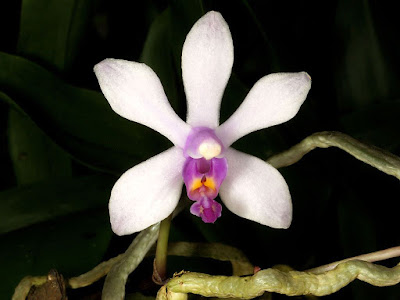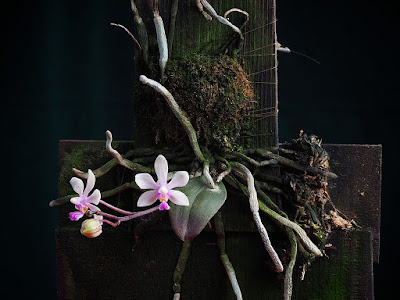Phalaenopsis wilsonii is native to Sichuan and Yunnan provinces in western China, in eastern Tibet, on the Likiang snow section and in the Yangtze catchment area, at an altitude of 1500-2150 m.
Phalaenopsis wilsonii orchid, also called as Wilson's Phalaenopsis (named after the English plant collector Wilson), Doritis wilsonii, Kingidium wilsonii, Phalaenopsis chuxiongensis, Phalaenopsis minior, Phalaenopsis wilsonii f. azurea, Polychilos wilsonii, is a species of the genus Phalaenopsis. This species was described by Rolfe in 1909.
IDENTIFY PHALAENOPSIS WILSONII ORCHID
Phalaenopsis wilsonii is native to Sichuan and Yunnan provinces in western China, in eastern Tibet, on the Likiang snow section and in the Yangtze catchment area, at an altitude of 1500-2150 m.
It is a miniature sized, warm to cold growing epiphyte with a short stem carrying 4 to 5, sometimes leafless or with 1 to 2 leaves at blooming, sometimes purplish, reddish abaxially when young, oblong to subelliptic leaves. The tiny leaves are only 1 cm long. They usually fall off and are not present at the time of flowering. In cultivation, plants can be healthier if they manage to maintain green leaves.
Wilson's Phalaenopsis blooms in the spring on an arcuate or pendant, simple, variable length to 8" (20 cm) long, zigzag inflorescence with a few, fragrant, simultaneously opening flowers. The flowers are 4 cm in diameter, which means they are very large in relation to the size of the leaves. The flowers have a delicate texture and shape of the star. The petals of both whorls are pink to white with purple coloration, while the lip is pink to dark crimson.
PHALAENOPSIS WILSONII ORCHID CARE AND CULTURE
Cultural information should only be used as a guide, and should be to be adapted to suit you. Your physical location; where you grow your plants, how much time you have to devote to their care, and many other factors, will need to be taken into account. Only then can you decide on the cultural methods that best suit you and your plants.
Light:
Phalaenopsis wilsonii needs a light level of 8000-12000 lux. It prefers a shaded position, without the direct rays of the sun. It is not a plant to keep outdoors even in summer, and it is advisable to keep it in home.
Temperature:
The average summer temperature is 23-25 ° C, night 14-17 ° C, giving a daily difference of 6-11 ° C. In winter, the average day temperature is 17-18 ° C, at night 0-2 ° C, and the daily difference increases to 16-18 ° C. The minimum temperature that can withstand in nature is about 0-2 ° C, but it is quite risky to try to apply it during cultivation.
Humidity:
Phalaenopsis wilsonii needs a humidity level of 80-90% in summer. To increase the humidity of the air around the plant, it is best to use an air humidifier, including it purposefully at night.
Substrate, growing media and repotting:
Wilson's Phalaenopsis can mounted or grow in pot with bark granulation 12-16 mm with moisture retention additives or sphagnum with perlite or charcoal for better drainage as substrate. Plants are best repotted after flowering, or when new roots begin to grow.
Watering:
In summer, the plants should be constantly moist. The best time to do the watering is in the morning, so that the plants have the opportunity to dry well before the arrival of the evening. Rainfall scheme is wet / dry.
Fertilizer:
It is recommended that 1/4-1/2 doses of fertilizer for orchids applied every week or every 2 weeks in the growing season. Before fertilizing the plant it is necessary to water it: in this way there is no risk that the fertilizer will burn the young roots.
Rest period:
To stimulate the flowering it will need a period of winter rest, characterized by the gradual lowering of the temperature. In the period of 2-3 winter months the amount of water should be limited to occasional fogging, fertilization halted, and humidity reduced to 60-70%.















I am a local grower in Yunnan. The coldest time in our city can reach minus 5 degrees.The Wilsons I plant outdoors will have 1 to 2 days of snow, and I think a cold resting period is very important for its blooming
DeleteAgree with you! Thank for your information!
Delete